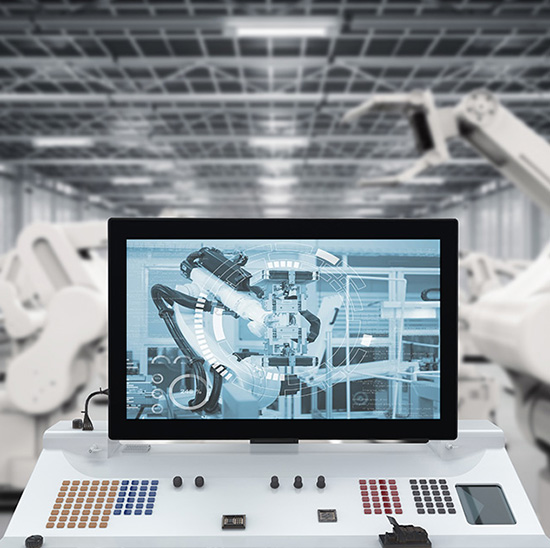In factory assembly lines—whether automotive, إلكترونيات, or appliance manufacturing—Industrial HMI Screen act as the “bridge” between operators and machinery. They display real-time production data, simplify control commands, and reduce human errors, directly impacting assembly speed and accuracy. لكن, with varied screen sizes, touch technologies, and durability standards, selecting the right Industrial HMI Screen for your specific assembly scenario can be challenging. This guide breaks down critical selection criteria, scenario-based recommendations, and common pitfalls to help you pick a screen that aligns with your assembly line’s needs.

Core Factors to Evaluate When Choosing Industrial HMI Screens
Not all Industrial HMI Screens are built for factory assembly—prioritize these factors to avoid mismatches:
1. Durability for Assembly Line Environments
Factory floors expose screens to dust, زيت, frequent cleaning, and occasional impacts. Look for:
تصنيف الحماية: Minimum IP65 (resists water splashes and dust—essential for food or automotive assembly with washdowns).
مادة الشاشة: Chemically strengthened glass or anti-scratch film (prevents damage from tools or accidental bumps).
تحمل درجة الحرارة: -10درجة مئوية إلى 60 درجة مئوية (handles fluctuations in workshops with heating or cooling systems).
2. حجم الشاشة & Resolution (Match Operator Workflow)
The right size ensures operators can read data without leaning in or straining:
شاشات صغيرة (5–7 inches): Ideal for compact machinery (على سبيل المثال, small electronics assembly stations) where space is limited.
شاشات متوسطة (10-15 بوصة): Best for general assembly lines (على سبيل المثال, automotive part fitting) needing to display 3–5 data points (سرعة, error alerts, counts).
شاشات كبيرة (17+ بوصات): Suitable for central control stations monitoring multiple assembly cells (requires high resolution: 1920×1080 or higher for clear multi-zone displays).
3. يلمس & Interface Compatibility
Assembly line operators need quick, accurate interactions—choose based on operation habits:
نوع اللمس: Resistive (يعمل مع القفازات, critical for electronics assembly with anti-static gloves) or capacitive (faster response for high-speed lines).
Input options: Ensure support for external keyboards/mice (useful for complex data entry, على سبيل المثال, custom assembly parameters).
تكامل البرمجيات: Compatible with your PLC (وحدة تحكم منطقية قابلة للبرمجة) and MES (Manufacturing Execution System) to sync real-time data.
4. Reliability & Maintenance
Assembly lines run 8–24 hours daily—downtime due to screen failures is costly:
MTBF (يعني الوقت بين الفشل): Aim for 50,000+ ساعات (أي ما يعادل 5+ سنوات من الاستخدام المستمر).
Easy replacement: تصميم وحدات (على سبيل المثال, detachable front panels) to reduce maintenance time (critical for lines with minimal shutdown windows).
Scenario-Based Recommendations for Factory Assembly
Different assembly environments demand tailored Industrial HMI Screens—here’s how to match them:
1. Automotive Assembly Lines
Needs: Resist oil, display real-time torque/position data, and work with heavy gloves.
Recommendation: 12–15 inch IP65-rated screens with resistive touch, 1000+ سطوع القمل (cuts glare from factory lighting).
2. Electronics Assembly (PCB/Battery Production)
Needs: Anti-static, compact size, and compatibility with precision control systems.
Recommendation: 7–10 inch screens with anti-static coating, اللمس بالسعة (for fine adjustments), and RS485 interface (syncs with PCB testers).
3. Large Appliance Assembly (Washers, Refrigerators)
Needs: Display multi-step workflows, durable against bumps from large parts.
Recommendation: 15–17 inch screens with reinforced frames, wide viewing angles (so operators at different stations can read), and built-in error-logging software.
FAQs About Industrial HMI Screens for Factory Assembly
س 1: Can Industrial HMI Screens work in dusty environments like metal stamping workshops?
A1: Yes—choose screens with IP66 protection (fully dust-tight) and fanless designs (avoids drawing in dust). Regularly wipe the screen with a dry cloth to prevent buildup.
Q2: How to ensure the HMI screen integrates with our existing assembly line software?
A2: Provide your supplier with your PLC model (على سبيل المثال, سيمنز S7-1200) and MES software version. Reputable suppliers will test compatibility and offer custom drivers if needed.
س 3: What’s the difference between Industrial HMI Screens and regular touchscreens?
A3: Regular touchscreens lack industrial-grade durability (على سبيل المثال, تصنيف IP, مقاومة درجات الحرارة) and can’t sync with manufacturing equipment. Industrial HMI Screens are built for 24/7 operation and seamless machine communication.
س 4: How long do Industrial HMI Screens last in assembly lines?
A4: مع الصيانة المناسبة (avoiding harsh chemicals, regular cleaning), they typically last 5–8 years. Screens in high-vibration environments (على سبيل المثال, near stamping machines) may need replacement after 4–6 years.
Choosing the right Industrial HMI Screen for factory assembly hinges on matching durability, مقاس, and compatibility to your specific line’s needs—whether it’s automotive, إلكترونيات, or appliance manufacturing. The right screen reduces errors, speeds up operations, and minimizes downtime.
If you’re unsure which Industrial HMI Screen fits your assembly line (على سبيل المثال, need help with size selection or software integration), املأ النموذج على موقعنا. Our team will analyze your workshop environment, equipment models, and workflow requirements to recommend a tailored solution within 24 hours—helping you optimize your assembly process and avoid costly mistakes.

